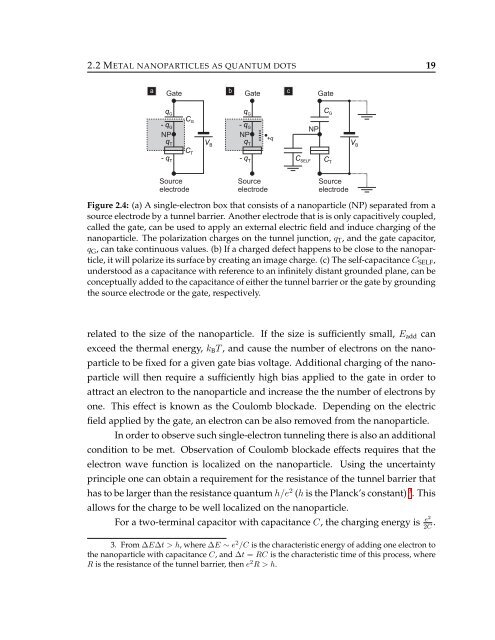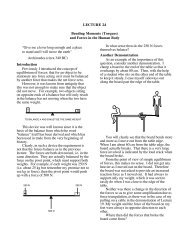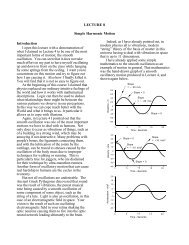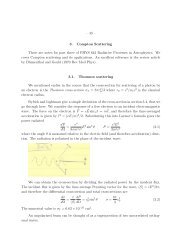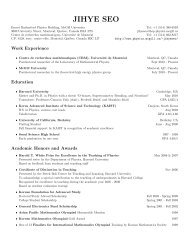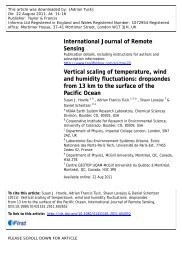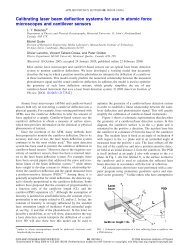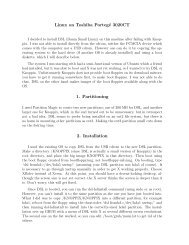Atomically defined tips in scanning probe microscopy - McGill Physics
Atomically defined tips in scanning probe microscopy - McGill Physics
Atomically defined tips in scanning probe microscopy - McGill Physics
You also want an ePaper? Increase the reach of your titles
YUMPU automatically turns print PDFs into web optimized ePapers that Google loves.
2.2 METAL NANOPARTICLES AS QUANTUM DOTS 19a Gateb Gate cGateq Gq GC GC G- q G- q GNPNPq TV Bq T+qNPV BC T- q T- q TC SELFC TSourceelectrodeSourceelectrodeSourceelectrodeFigure 2.4: (a) A s<strong>in</strong>gle-electron box that consists of a nanoparticle (NP) separated from asource electrode by a tunnel barrier. Another electrode that is is only capacitively coupled,called the gate, can be used to apply an external electric field and <strong>in</strong>duce charg<strong>in</strong>g of thenanoparticle. The polarization charges on the tunnel junction, q T , and the gate capacitor,q G , can take cont<strong>in</strong>uous values. (b) If a charged defect happens to be close to the nanoparticle,it will polarize its surface by creat<strong>in</strong>g an image charge. (c) The self-capacitance C SELF ,understood as a capacitance with reference to an <strong>in</strong>f<strong>in</strong>itely distant grounded plane, can beconceptually added to the capacitance of either the tunnel barrier or the gate by ground<strong>in</strong>gthe source electrode or the gate, respectively.related to the size of the nanoparticle. If the size is sufficiently small, E add canexceed the thermal energy, k B T , and cause the number of electrons on the nanoparticleto be fixed for a given gate bias voltage. Additional charg<strong>in</strong>g of the nanoparticlewill then require a sufficiently high bias applied to the gate <strong>in</strong> order toattract an electron to the nanoparticle and <strong>in</strong>crease the the number of electrons byone. This effect is known as the Coulomb blockade. Depend<strong>in</strong>g on the electricfield applied by the gate, an electron can be also removed from the nanoparticle.In order to observe such s<strong>in</strong>gle-electron tunnel<strong>in</strong>g there is also an additionalcondition to be met. Observation of Coulomb blockade effects requires that theelectron wave function is localized on the nanoparticle.Us<strong>in</strong>g the uncerta<strong>in</strong>typr<strong>in</strong>ciple one can obta<strong>in</strong> a requirement for the resistance of the tunnel barrier thathas to be larger than the resistance quantum h/e 2 (h is the Planck’s constant) 3 . Thisallows for the charge to be well localized on the nanoparticle.For a two-term<strong>in</strong>al capacitor with capacitance C, the charg<strong>in</strong>g energy is e22C .3. From ∆E∆t > h, where ∆E ∼ e 2 /C is the characteristic energy of add<strong>in</strong>g one electron tothe nanoparticle with capacitance C, and ∆t = RC is the characteristic time of this process, whereR is the resistance of the tunnel barrier, then e 2 R > h.


